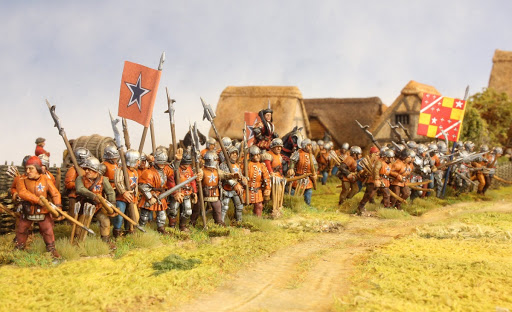
"Early Tudor Warfare, 1485-1499" Topic
5 Posts
All members in good standing are free to post here. Opinions expressed here are solely those of the posters, and have not been cleared with nor are they endorsed by The Miniatures Page.
Please do not post offers to buy and sell on the main forum.
For more information, see the TMP FAQ.
Back to the Renaissance Discussion Message Board Back to the Medieval Discussion Message Board
Areas of InterestMedieval
Renaissance
Featured Hobby News Article
Featured Link
Featured Ruleset
Featured Showcase Article The Editor tries out a boardgame - yes, a boardgame - from battle-market magazine.
Featured Profile Article
|
| Tango01 | 16 Feb 2021 4:28 p.m. PST |
"The Tudor age is thoroughly implanted in popular history with King Henry VIII, his many wives, and the continuation of the golden age of renaissance England at the forefront. From a military history viewpoint, the era is dominated by renewed wars with Scotland and France, and the founding of the English navy. Little studied however is the important middle age between the end of the dynastic civil wars, known as the War of the Roses, 1455-1487, and the beginning of the renaissance age of warfare. King Henry VII (b.1457-1509) left a lasting effect on the nation during his relatively short reign, which included the ending the military power of the lord and nobles; breaking up the armed retinues which were loyal to their lordships and not to the country or the crown. This was a crucial period in the post-medieval military history of England, besides the formation of the Yeomen of the Guard, King Henry VII and his followers finally ended their long dynastic civil war, defeated three armed rebellions against early Tudor rule, and laid the foundation for future English naval supremacy. The early period of Tudor warfare is obviously rooted in the preceding conflict known as the Wars of the Roses, although it was not named as such in any medieval or renaissance histories. The Wars of the Roses was not a singular conflict but a series of scattered battles, skirmishes, sieges, and coups between many different rival factions and extended families. From May of 1455 to June of 1487, England was divided between armed retainers and soldiers who were employed or who owed allegiance to varying earls, lords, and dukes in support of two principal families' claim to the throne, York, and the royal house of Lancaster led by King Henry VI (b.1421-1471). Though this is a great oversimplification of the issues which led to such a long conflict. A complex series of events took place in the later half of the Lancastrian-Yorkist conflict, 1470-1485. The Earl of Warwick, once a staunch Yorkist supporter of both the Duke of York and later King Edward, turned coat and joined the Lancastrian resistance led by Queen Margaret and the Prince of Wales. Adding greater ignominy, the Duke of Clarence, King Edward's brother, conspired against him as well. His other younger brother, Richard the Duke of Gloucester (b.1452-1485), remained loyal however. What followed was the period known as the Readeption; Henry VI regained his crown from October 1470 until April 1471 but it was the Queen and Earl of Warwick who truly ruled. King Edward soon returned from exile, defeating and killing the Earl of Warwick at the Battle of Barnet. In May 1471, the Yorkists decisively defeated the Lancastrians at Shrewsbury with the Prince of Wales captured and summarily executed. After Henry VI's death in the same month, the only surviving male Lancastrian with an even distant claim to the throne was the then fourteen year old Henry Tudor, Earl of Richmond…"

Main page
link
Amicalement
Armand
|
| Warspite1 | 16 Feb 2021 5:37 p.m. PST |
I would point out that the blue star within a white star (shown above) is incorrect.
It is an unfortunate error first started by the Lance and Longbow's Standard and Banners book. I have discussed the matter with the author. The blue within white star (mullet) is from a much later – 16th century – De Vere device and may actually date to BEFORE he succeeded to the earldom of Oxford as the inner star(mullet) is also a cadency mark indicating a third son. This blue mullet of cadency should be removed when he succeeded to the title. It is unclear from the Tudor source if it had been removed. This can be confirmed here:
link
where you can see the 13th earl's shield, copied from his stall plate as a Knight of the Garter. The 13th earl was not made a KG until AFTER the Wars of the Roses. Barry |
| BillyNM | 17 Feb 2021 12:06 a.m. PST |
Superior Cornish longbows? |
Tgerritsen  | 17 Feb 2021 7:03 a.m. PST |
Maybe the painter is just a Cowboys fan? :) |
| Tango01 | 17 Feb 2021 12:27 p.m. PST |
|
|

